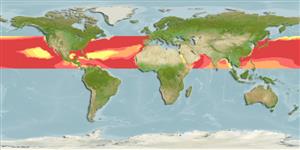>
Scombriformes (Mackerels) >
Tetragonuridae (Squaretails)
Etymology: Tetragonurus: Greek, tetra = four + Greek, gonia = angle + Greek, oura = tail (Ref. 45335).
More on author: Lowe.
Environment: milieu / climate zone / depth range / distribution range
Ökologie
seewasser; ozeanodrom (Ref. 51243); tiefenbereich 0 - 800 m (Ref. 10823), usually 0 - 91 m (Ref. 7251). Subtropical; 47°N - 8°N
Atlantic, Indian and Pacific: in tropical and subtropical waters. Western Atlantic: Nova Scotia in Canada to Panama (Ref. 7251).
Size / Gewicht / Alter
Maturity: Lm ? range ? - ? cm
Max length : 50.0 cm TL Männchen/unbestimmt; (Ref. 4415)
Kurzbeschreibung
Morphologie | Morphometrie
Rückenflossenstacheln (insgesamt): 14 - 17; Rückenflossenweichstrahlen (insgesamt): 10-13; Afterflossenstacheln 1; Afterflossenweichstrahlen: 9 - 12; Wirbelzahl: 44 - 51. Light brown to nearly black in color.
Oceanic, mostly in the upper 91 m but adults probably deeper (Ref. 7251). Occasionally strays close to shore (Ref. 7251). Young commonly inquiline in pelagic tunicates, especially Salpa and Pyrosoma (Ref. 11149). Feeds on soft-bodied medusae, ctenophores and especially salps; will also take plankton (Ref. 11149). The flesh may be poisonous (Ref. 27121).
Life cycle and mating behavior
Geschlechtsreife | Fortpflanzung | Ablaichen | Eier | Fecundity | Larven
Haedrich, R.L., 1986. Tetragonuridae. p. 851. In M.M. Smith and P.C. Heemstra (eds.) Smiths' sea fishes. Springer-Verlag, Berlin. (Ref. 4415)
IUCN Rote Liste Status (Ref. 130435)
Bedrohung für Menschen
Poisonous to eat (Ref. 27121)
Nutzung durch Menschen
Fischereien: nicht kommerziell
Mehr Information
ReferenzenAquakulturAquakultur ProfilZuchtlinienGenetikElectrophoresesVererbbarkeitKrankheitenVerarbeitungNutrientsMass conversion
PartnerBilderStamps, Coins Misc.LauteCiguateraGeschwindigkeitSchwimmstilKiemenoberflächeOtolithsGehirngrößeSehfähigkeit
Tools
Zusatzinformationen
Download XML
Internet Quellen
Estimates based on models
Preferred temperature (Ref.
123201): 13.9 - 28.5, mean 24.8 °C (based on 1976 cells).
Phylogenetic diversity index (Ref.
82804): PD
50 = 0.7500 [Uniqueness, from 0.5 = low to 2.0 = high].
Bayesian length-weight: a=0.00389 (0.00180 - 0.00842), b=3.12 (2.94 - 3.30), in cm total length, based on all LWR estimates for this body shape (Ref.
93245).
Trophic level (Ref.
69278): 3.6 ±0.37 se; based on food items.
Widerstandsfähigkeit (Ref.
120179): niedrig, Verdopplung der Population dauert 4,5 - 14 Jahre. (Preliminary K or Fecundity.).
Fishing Vulnerability (Ref.
59153): Moderate vulnerability (40 of 100).
